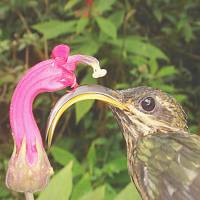Researchers have constructed the complicated family tree of hummingbirds using genetic information from most of the world's 338 hummingbird species and their closest relatives. They said hummingbirds can be divided into nine groups, with differences in size, habitat, feeding strategy and body shape.
The common ancestor to all species in existence today lived about 22 million years ago in South America, several million years after hummingbirds were known to be flourishing in Europe, they said in a study published in the journal Current Biology. Today's hummingbirds are found only in the Americas.
The discovery of fossils in Germany of the oldest known hummingbirds — 30 million years old — was announced in 2004.
The hummingbird evolutionary lineage split from a related group of small birds called swifts and tree swifts about 42 million years ago — most likely in Europe or Asia — and by 22 million years ago the ancestral species of modern hummingbirds was in South America, the researchers said.
Hummingbirds found their way to South America probably after crossing a land bridge that once connected Siberia to Alaska, the researchers said. Once in South America, they expanded into new ecological niches and evolved new species, then spread back to North America about 12 million years ago and into the Caribbean about 5 million years ago, the researchers said.



